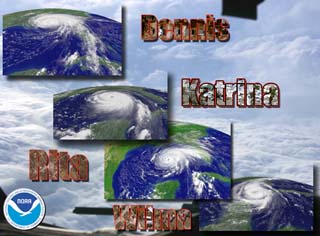| NOAA Magazine || NOAA Home Page |
DENNIS,
KATRINA, RITA, STAN AND WILMA "RETIRED" FROM LIST OF STORM
NAMES
International Committee Selects Replacement Names for 2011 List
 April
6, 2006 � Hurricanes Dennis, Katrina, Rita, Stan and Wilma, all from
the historic 2005 Atlantic hurricane season, were "retired"
by an international hurricane committee of the World Meteorological
Organization, which includes the NOAA
National Hurricane Center, during their annual meeting in San Juan,
Puerto Rico. Now retired, these five storms, part of last season's record-setting
28 named storms and 15 hurricanes, will not reappear on the list of
potential storm names that is otherwise recycled every six years. (Click
NOAA illustration for larger view of Hurricanes Dennis, Katrina, Rita
and Wilma. Click
here for high resolution version. Please credit “NOAA.”)
April
6, 2006 � Hurricanes Dennis, Katrina, Rita, Stan and Wilma, all from
the historic 2005 Atlantic hurricane season, were "retired"
by an international hurricane committee of the World Meteorological
Organization, which includes the NOAA
National Hurricane Center, during their annual meeting in San Juan,
Puerto Rico. Now retired, these five storms, part of last season's record-setting
28 named storms and 15 hurricanes, will not reappear on the list of
potential storm names that is otherwise recycled every six years. (Click
NOAA illustration for larger view of Hurricanes Dennis, Katrina, Rita
and Wilma. Click
here for high resolution version. Please credit “NOAA.”)
Dennis, Katrina, Rita, Stan and Wilma represent the type of devastating storm that is "retired" for causing a large loss of life and property. These names will not be used again for sensitivity reasons and to establish distinction within the scientific and legal communities.
For 2011, Dennis, Katrina, Rita, Stan and Wilma have been replaced with Don, Katia, Rina, Sean and Whitney, respectively.
Since tropical cyclones were first named in 1953, 67 names have been retired (the first being Carol and Hazel in 1954), and with a total of five, 2005 has the most retired storm names in a single season (previous record: four in 1955, 1995 and 2004).
A synopsis of the newly retired storms:
- Dennis began its path of destruction in early July while passing between Jamaica and Haiti and then crossing Cuba with estimated top winds of 140 mph. After tracking north across the eastern Gulf of Mexico, Dennis came ashore on Santa Rosa Island, Fla., as a Category 3 hurricane on July 10 with top winds estimated at 120 mph. At least 54 deaths are directly or indirectly attributed to Dennis, including 15 in the U.S, most from within Florida.
- Katrina became the costliest and one of the deadliest hurricanes in U.S. history with damage costs exceeding $50 billion and fatalities, directly and indirectly, topping 1,300. Katrina came ashore at Buras, La., as a Category 3 hurricane on August 29 with top winds estimated at 125 mph. Additionally, Katrina was a Category 1 hurricane when it first struck the U.S. near the Broward/Miami-Dade County line in Florida on August 24 after bringing tropical storm conditions to the northern Bahamas.
- Rita made landfall in extreme southwestern Louisiana, near the Texas border, as a Category 3 hurricane with top winds of 115 mph on September 24. Rita reached Category 5 strength with top winds estimated at 180 mph over the central Gulf of Mexico, where it had the fourth-lowest central pressure on record (895 millibars) in the Atlantic Basin. Rita produced a significant storm surge that devastated coastal communities in southwestern Louisiana, and its wind, rain, and tornadoes caused fatalities and a wide swath of damage from eastern Texas to Alabama. Rita also produced storm surge flooding in parts of the Florida Keys as the storm's center passed between the Keys and Cuba en route to the Gulf Coast.
- Stan, in combination with other weather features, produced torrential rainfall in Mexico and Central America where the combined death toll is estimated to be as high as 2,000. Stan first crossed Mexico's Yucatan Peninsula as a tropical storm, then moved southwest across the Bay of Campeche and hit as a Category 1 hurricane about 90 miles southeast of Veracruz, Mexico, on October 4.
- Wilma was an extremely intense Category 5 hurricane over the northwestern Caribbean Sea with estimated tops winds of 185 mph and the all-time lowest central pressure (882 millibars) for an Atlantic Basin hurricane. A slow-moving Wilma devastated coastal areas of the northeastern Yucatan Peninsula of Mexico as a Category 4 hurricane. It later raced into South Florida—coming ashore near Cape Romano, Fla., at Category 3 intensity with top winds estimated at 120 mph on October 24—and inflicting extensive damage.
Names for the upcoming 2006 season, which begins June 1, include Alberto, Beryl, Chris, Debby, Ernesto, Florence, Gordon, Helene, Isaac, Joyce, Kirk, Leslie, Michael, Nadine, Oscar, Patty, Rafael, Sandy, Tony, Valerie, William. On this list Kirk replaces Keith, which was retired following its impact on Mexico and Belize in 2000.
NOAA, an
agency of the U.S. Department of
Commerce, is dedicated to enhancing economic security and national
safety through the prediction and research of weather and climate-related
events and providing environmental stewardship of the nation's coastal
and marine resources.
Through the emerging Global Earth Observation System of Systems (GEOSS),
NOAA is working with its federal partners, 61 countries and the European
Commission to develop a global network that is as integrated as the
planet it observes, predicts and protects.
Relevant Web Sites
NOAA National Hurricane Center
NOAA Satellite Images of 2005 Storm Events
NOAA Storm Reports (PDF):
Media
Contact:
Chris Vaccaro, NOAA
National Weather Service, (301) 713-0622 ext. 142